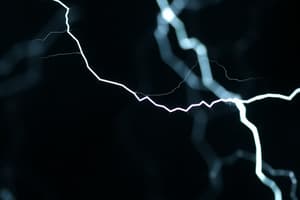Podcast
Questions and Answers
What is the unit used to measure electric current?
What is the unit used to measure electric current?
- Watts
- Amperes (correct)
- Joules
- Coulombs
How many electrons pass a specific point every second for one ampere of current?
How many electrons pass a specific point every second for one ampere of current?
- 6.24 x 10^18 (correct)
- 6 x 10^23
- 1.6 x 10^-19
- 6.24 x 10^23
Which formula represents power in an electrical circuit?
Which formula represents power in an electrical circuit?
- P = I/V
- P = V + I
- P = V/I (correct)
- P = IR
What did Alessandro Volta invent in 1791 that contributed to the evolution of current electricity?
What did Alessandro Volta invent in 1791 that contributed to the evolution of current electricity?
What does power represent in an electrical circuit?
What does power represent in an electrical circuit?
Which component of an electrical circuit is measured in volts?
Which component of an electrical circuit is measured in volts?
Flashcards are hidden until you start studying
Study Notes
What is Current Electricity?
Current electricity refers to electric current flowing through a conductor when voltage is applied across it. In other words, it's the flow of electrons from one place to another due to the force exerted by a battery or power supply. This flow can occur in wires, conductors, and even liquids like water, if charged particles can move through them.
Understanding Amperes and Watts
Electric current is measured in amperes (A), which is the amount of charge passing any point on the conductor per unit time. One ampere represents the movement of 6.24 x 10^18 electrons past a specific point every second. This number is derived from Avogadro's constant, which is approximately 6 x 10^23 molecules per mole; since there are six protons and six electrons in each atom, we get 1.6 x 10^-19 charges per atom.
Power is often described in terms of two measures—wattage and voltage. Power is the rate at which energy flows and is also known as the product of both voltage and current. In formulaic terms, power is P = VI, where P stands for power in watts, V is the voltage in volts, and I is the current in amps.
History of Current Electricity
The concept of current electricity has evolved over time with several key milestones. In 1791, Alessandro Volta invented the pile or voltaic pile, consisting of alternating layers of zinc and copper, separated by cloth soaked in brine solution. This device was an early form of battery, able to produce small amounts of electrical current. Later, Michael Faraday began his pioneering work on electromagnetic induction and discovered that electric current could be produced without touching any part of a circuit. These discoveries laid the foundation for our understanding of current electricity.
Today, the study of current electricity is intertwined with various aspects of physics, including Ohm's Law, Kirchhoff's laws, and Maxwell's equations. These principles help us understand how current electricity behaves within circuits and devices, allowing us to design and build advanced technologies such as computers, smartphones, electric vehicles, and more.
Studying That Suits You
Use AI to generate personalized quizzes and flashcards to suit your learning preferences.




